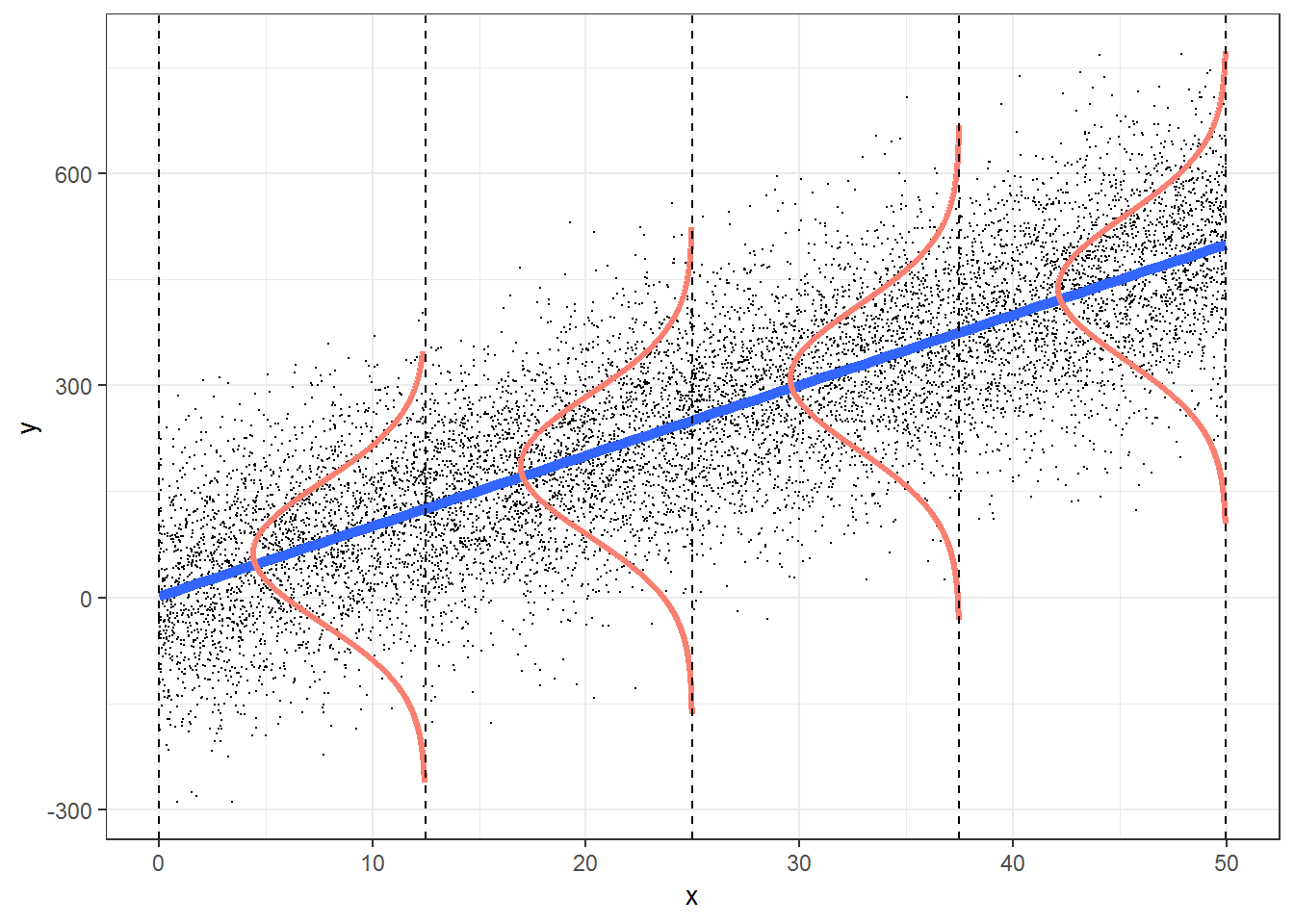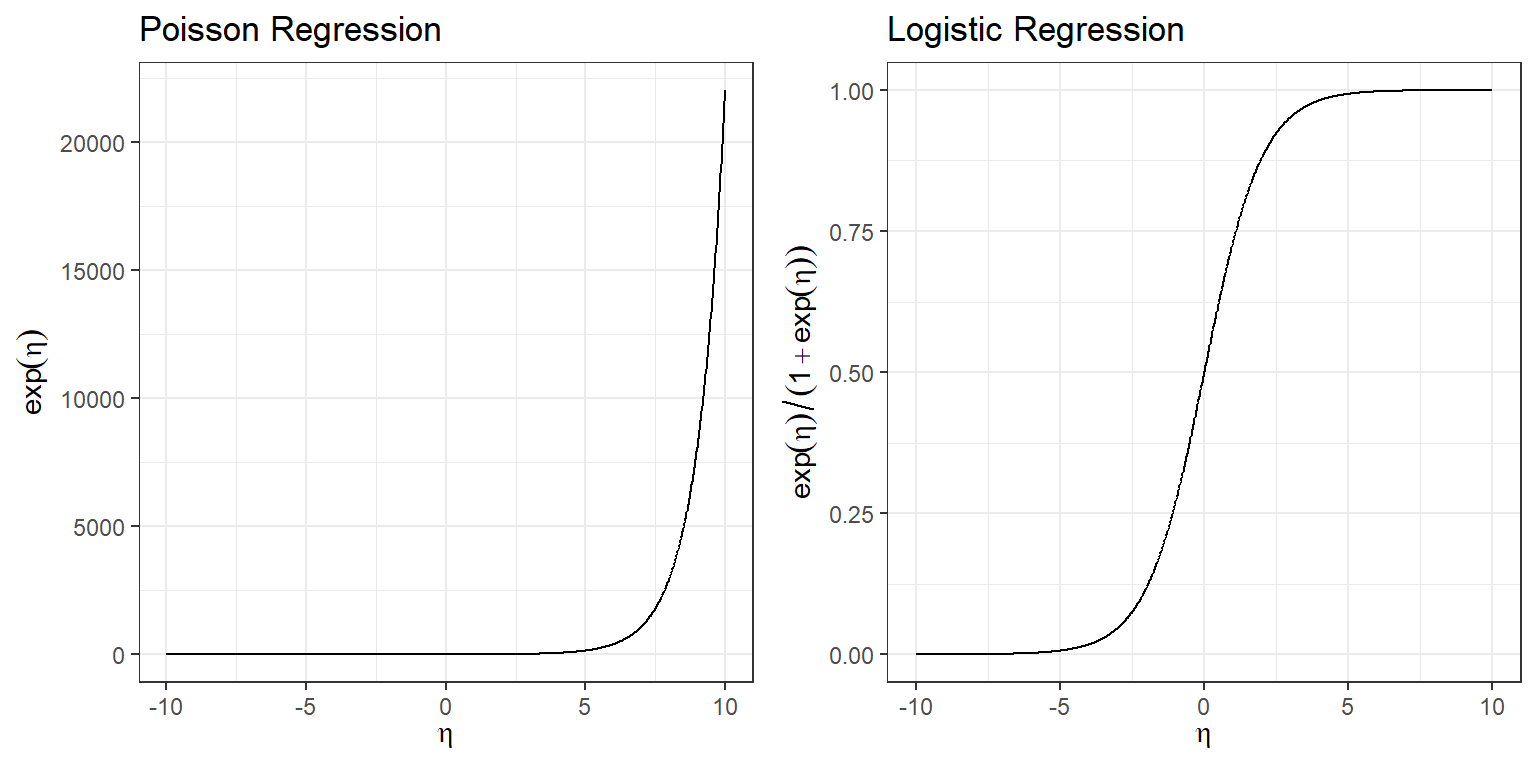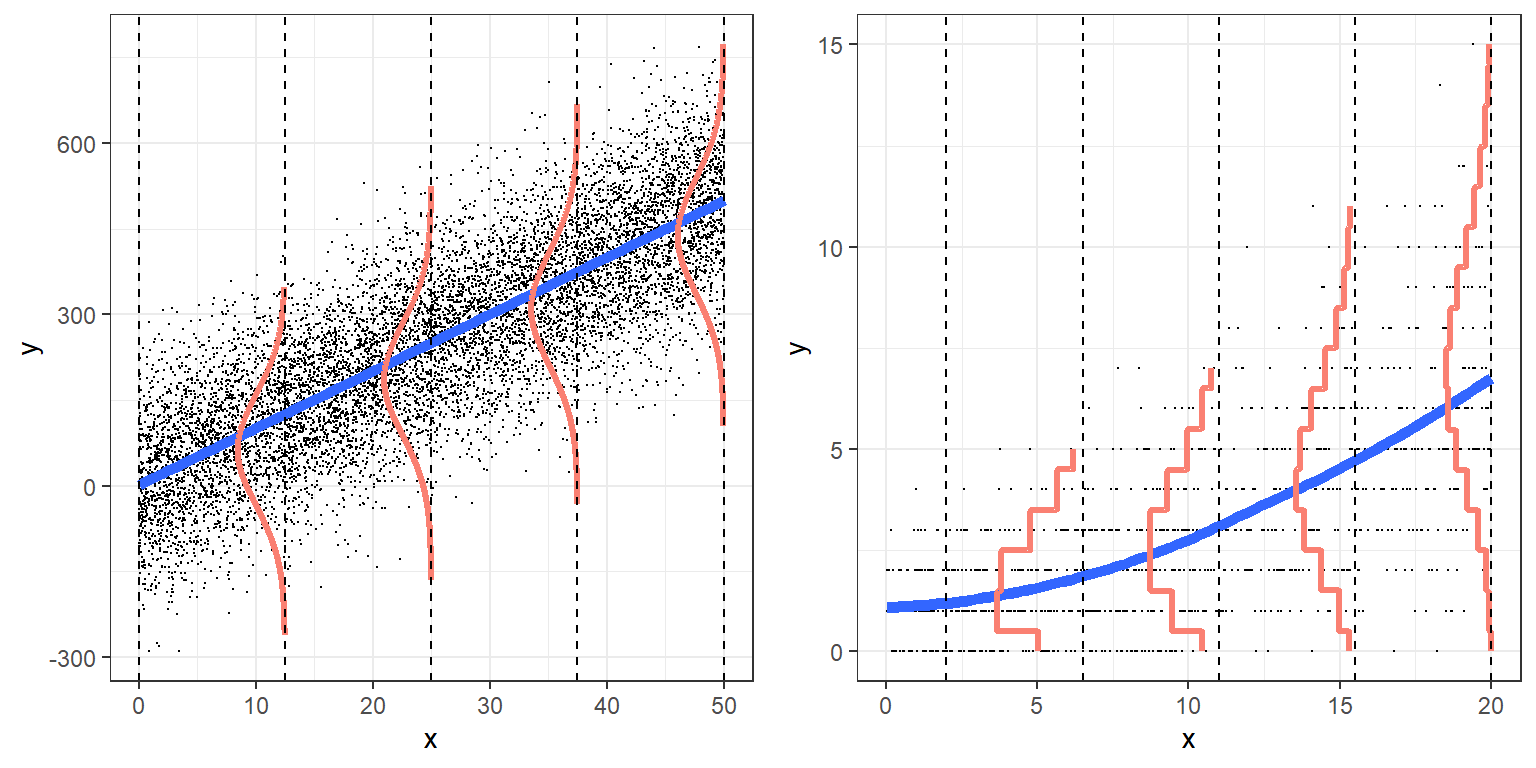library(knitr) # for setting options when knitting
library(ggplot2) # for plots
library(patchwork) # for multi-panel plots
library(gridExtra) # another option for multi-panel plots
library(dplyr) # for data wrangling14 Introduction to generalized linear models (GLMs)
Learning objectives
Understand the role of random variables and common statistical distributions in formulating modern statistical regression models.
Be able to describe a variety of statistical models and their assumptions using equations and text.
14.1 R packages
We begin by loading a few packages upfront:
14.2 The Normal distribution as a data-generating model
In introductory statistics courses, it is customary to see linear models written in terms of an equation that decomposes a response variable into a signal + error as below:
This decomposition is made possible because the Normal distribution has separate parameters that describe the mean (
Instead of writing the linear model in terms of signal + error, we can write the model down by specifying the probability distribution of the response variable and indicating whether any of the parameters in the model are functions of predictor variables. For example, the model in Equation 14.1 can be written as:
This description highlights that: 1) the distribution of
As usual, I think it is helpful to also visualize the model (depicted in Figure 14.1) for a model containing a single predictor,
14.3 Generalized linear models
14.3.1 Nomenclature
One thing that is sometimes confusing is the difference between General Linear Models and Generalized Linear Models. The term General Linear Model is used to acknowledge that several statistical methods, listed below, can all be viewed as fitting a linear model with the same underlying assumptions (linearity, constant variance, normal residuals, and independence):
- A t-test is a linear model with a single categorical predictor with 2 levels.
- ANOVA is a linear model with a single categorical predictor with
- ANCOVA is a linear model containing a continuous predictor and a categorical predictor, but no interaction between the two (thus, the different groups have a common slope) .
- More generally, models may include a mix of continuous and categorical variables and possible interactions between variables.
Generalized** linear models, by contrast, refers to a broader class of models that allow for alternative probability distributions in addition to the Normal distribution. Historically, the development of generalized linear models focused on statistical distributions in the exponential family (McCullagh and Nelder 1989), which includes the normal distribution with constant variance, Poisson, Binomial, Gamma, among others. These distributions can all be written in a specific form (Equation 14.2), which facilitated the development of common methods for model fitting and a unified theory for interpreting model parameters (McCulloch and Neuhaus 2005):
If you were to take a class on generalized linear models in a statistics department, you would likely be required to show that various statistical distributions (e.g., those listed above) can be written in this form. You might also learn how derive the mean and variance of each distribution from this general expression (see e.g., Table 2.1 from McCullagh and Nelder 1989; Section 8.7 of Zuur et al. 2009). The fact that it is possible to derive general results for distributions in the exponential family is really quite cool! At the same time, you do not need to work through those exercises to be able to use generalized linear models to analyze your data. Furthermore, it is relatively easy to extend the basic conceptual approach (constructing models where we express parameters of common statistical distributions as a function of predictor variables) to allow for a much richer class of models - i.e., there is no need to limit oneself to distributions from the exponential family.
14.4 Describing the data-generating mechanism
With distributions other than the Normal distribution, we will no longer be able to write our models in terms of a signal + error. Yet, it may still be conceptually useful to consider how these models capture systematic and random variation in the data. Systematic variation is captured by modeling some transformation of the mean,
Systematic component:
Random component:
- We write
Examples of generalized linear models are given below.
Linear Regression:
Poisson regression:
Logistic regression:
14.4.1 Link functions,
Link functions allow the systematic component (
eta<-seq(-10,10, length=1000)
mean.Poisson<-exp(eta)
mean.Logistic<-exp(eta)/(1+exp(eta))
pdat<-data.frame(eta, mean.Poisson, mean.Logistic)
p1<-ggplot(pdat,aes(eta, mean.Poisson))+geom_line()+
xlab(expression(eta))+ylab(expression(exp(eta)))+ggtitle("Poisson Regression") + theme_bw()
p2<-ggplot(pdat,aes(eta, mean.Logistic))+geom_line()+
xlab(expression(eta))+ylab(expression(exp(eta)/(1+exp(eta))))+
ggtitle("Logistic Regression") + theme_bw()
gridExtra::grid.arrange(p1, p2, nrow=1)Poisson Regression:
Logistic regression:
Now that we have defined terms and seen how these definitions apply to specific distributions, let’s consider a hypothetical example using the Poisson regression.
14.5 Example: Poisson regression for pheasant counts
Consider a wildlife researcher that is interested in modeling how pheasant abundance varies with the amount of grassland cover. She divides the landscape up into a series of plots. She and several colleagues walk transects in these plots with their hunting dogs to locate and flush pheasants, leading to a count in each plot,

We could fit a Poisson regression model (we will see how to do this in R in ) in which the mean count depends on grassland abundance. To describe the model using equations, we would write:
Because the mean of the Poisson distribution is
In English, we model the log of the mean as a linear function of grassland abundance (this is the systematic component of the model). Further, we assume the counts,
14.5.1 Poisson regression assumptions
These next two subsections were slightly modified from the online version of Roback and Legler (2021), which is licensed under Creative Commons Attribution-NonCommercial-ShareAlike 4.0 International License.
Much like with linear regression, we can list the underlying assumptions of Poisson regression:
- Poisson Response: The response variable is a count per unit of time or space, described by a Poisson distribution.
- Independence: The observations must be independent of one another.
- Mean=Variance: By definition, the mean of a Poisson random variable must be equal to its variance.
- Linearity: The log of the mean rate, log(
Figure 14.4 illustrates a comparison of linear regression and Poisson regression models.
- For the linear regression model (left panel of Figure 14.4), the responses appear to be approximately normal for any given value of
- In the linear regression model, the variation in
- In the case of linear regression, the mean responses for each level of


